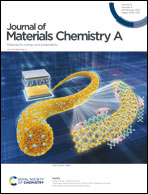Porous bismuth antimony telluride alloys with excellent thermoelectric and mechanical properties†
Abstract
p-Type BiSbTe alloys possess the highest ZT near room temperature, but inferior mechanical properties due to the atomically layered structure with weak van der Waals interactions. Here we report the successful preparation of porous BiSbTe alloys by sequential high-pressure synthesis, ball milling, and spark plasma sintering. Porosity usually has a negative effect on the material's mechanical properties. However, both thermoelectric and mechanical properties of our porous bulks are greatly enhanced, which benefit from the unique microstructure featuring closely bonded equiaxed grains and uniformly distributed pores (with a porosity of ca. 0.15). The optimal Bi0.42Sb1.58Te3 shows a maximum ZT of 1.27 around 350 K and an average ZT of 1.15 in the measured temperature range of 298–463 K. Furthermore, excellent mechanical properties including hardness, bending and compressive strengths are achieved in these porous samples, which are competitive with (or even better than) those of dense samples. The current structural architecture strategy can promote the development of porous thermoelectric materials, especially materials with similar anisotropic crystal structures.



 Please wait while we load your content...
Please wait while we load your content...